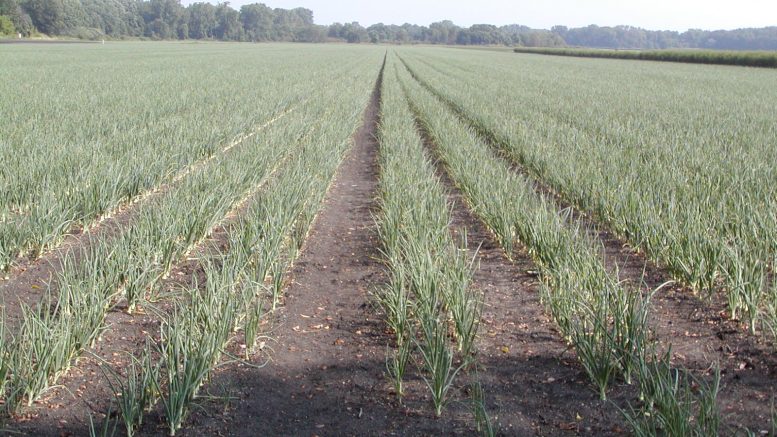By Bernard Zandstra, Michigan State University
Onion acreage in Michigan peaked at about 13,000 acres in 1935 when most of the virgin muck areas had been drained and cleared. Onion acreage has declined to about 2,500 acres in 2016. With no new muck areas to clear and farm, some growers plant onion crop after onion crop on their farms, or rotate on a two- to three-year schedule. Others are turning to well-drained, irrigated sandy soil for onion production. Both types of production have serious weed problems. Onions are not very competitive with weeds, and any weeds present in the fields will reduce yield. With a history of moderate yields, Michigan onion growers need every advantage they can obtain to enhance productivity and profits.
Michigan State University (MSU) researchers and Extension educators work with onion growers in field experiments to improve weed control. On the basis of field research, new labels are obtained through cooperation of MSU, the IR-4 Project and the chemical industry.
Pre-emergence and post-emergence onion weed control experiments were conducted on muck and mineral soil in Michigan in 2016. The objectives were to 1) develop data and a use pattern to support registration of pyroxasulfone (Zidua) on onion, 2) develop data and a use pattern for use of bicyclopyrone on onion, 3) test currently registered and potential new herbicides to find effective methods for use on onion, and 4) obtain crop safety data to support registration of clopyralid (Stinger) post-emergence on onion.
New Herbicides Safe on Onions
Pyroxasulfone (Zidua 85 WDG) is a very long chain fatty acid synthesis inhibitor (WSSA/HRAC group 15 K3), similar to Dual Magnum in activity. It has different chemistry than Dual Magnum and is active at lower rates. Zidua has been safe on onion when applied at 0.133 lb active ingredient (ai) per acre (2.5 oz.) pre-emergence and after onions have emerged. Zidua in sequence with Prowl H2O improved control of redroot pigweed and ladysthumb over Prowl H2O alone. Zidua is effective against annual grasses, common chickweed, common groundsel, common purslane, eastern black nightshade and spotted spurge.
Bicyclopyrone (1.67 SL) is an HPPD inhibitor (WSSA/HRAC group 27F2). It appears to have sufficient selectivity for pre-emergence and post-emergence application on onion on muck soil. In 2016, it was applied at 0.033 and 0.045 lb ai per acre once or twice alone or with Prowl H2O, bromoxynil or Chateau. In all tank mixes, it was safe pre-emergence on the onions. It was applied post-emergence with GoalTender or after GoalTender. Onion yield was not reduced by any bicyclopyrone treatment. Bicyclopyrone will improve control of annual grasses, common lambsquarters, common ragweed, eastern black nightshade, redroot pigweed, shepherd’s purse and wild radish.
Prowl H2O 1.9 lb ai per acre (2 qt.) plus bromoxynil 0.19 lb ai per acre (12 fl. oz.) applied pre-emergence followed by bicyclopyrone 0.033 lb plus Chateau 0.032 lb (1 oz.) post-emergence, and Prowl H2O 1.9 lb plus Chateau 0.032 lb plus bromoxynil 0.19 lb pre-emergence resulted in better ladysthumb and redroot pigweed control and increased onion yields. If the ladysthumb was not controlled early in the season, it escaped later herbicide applications and had to be removed by hand.
Use of GoalTender
GoalTender applied at 0.063, 0.125 and 0.25 lb ai per acre (2, 4 or 8 fl. oz.) four times starting at the onion one-leaf stage (1 LS) resulted in good yield and acceptable ladysthumb and redroot pigweed control. Combining Chateau 0.032 lb (1 oz.) with the first three applications of GoalTender (1 LS, 2 LS, 3-4 LS) improved weed control with no yield reduction. Reflex 0.125 lb applied at the two and three- to four-leaf stage, after GoalTender at the one-leaf stage, was safe on onion and produced weed control similar to GoalTender. Reflex is similar chemically to GoalTender and controls many of the same weeds. Four applications of GoalTender and two of Reflex would improve season-long post-emergence weed control.
Stinger improved control of ladysthumb but set the onions back and reduced yield. It may be labeled on onion for spot treatment control of composite weeds such as perennial sow thistle and Canada thistle.
On mineral soil, Prowl H2O was safe on onions at 0.95 lb ai (1 qt.) per acre. It provided good weed control at that rate for three to four weeks. Yield from this treatment was the largest in the mineral soil experiment. Zidua, bicyclopyrone and Chateau caused serious onion injury and yield reduction when applied pre-emergence on mineral soil.
Zidua, bicyclopyrone, Reflex and Stinger are moving through the registration process and should be labeled for use in onion within two to three years.
The GoalTender Special Local Needs Label (Section 24c) for Michigan was issued in 2014. The label allows application of GoalTender 4SC at the onion one fully expanded true-leaf stage. The label application rate is 2-6 fl. oz. of GoalTender (0.063-0.188 lb ai per acre). There is a maximum amount of GoalTender allowed per year of 16 fl. oz. (0.5 lb ai per acre). If applied at 4 fl. oz. each time, the label allows for four applications per crop, starting at the one-leaf stage. The label advises not to tank mix with adjuvants, oils, surfactants, fertilizer or other pesticides. The final GoalTender application should be made July 1-15 because of the 45-day pre-harvest interval (PHI). Onions that will be harvested in September may be sprayed slightly later.
Our research has demonstrated the importance of starting GoalTender application at the onion one-leaf stage. Very difficult weeds such as ladysthumb, common lambsquarters, marsh yellowcress, shepherd’s purse and eastern black nightshade are easier to control with the earlier initiation of GoalTender applications. Onions will not suffer permanent injury from GoalTender and will reach maximum yields. If the weeds are not killed, the onions will suffer yield reduction.
The use of Goal 2XL increases herbicidal activity against larger weeds because of the more active petroleum solvent carrier in Goal 2 XL. After the two-leaf stage, onions growing well with normal leaf wax will tolerate Goal 2 XL and not suffer yield reduction. If onions are growing slowly in cool, cloudy weather, it is preferable to use the GoalTender formulation.
Season-Long Weed Control
An onion weed control program on muck soil should begin with an application of Prowl H2O 2 qt. plus bromoxynil 8-16 fl. oz. per acre after seeding onions and just before onions emerge. By waiting one to two weeks after seeding the onions and cover crop to apply the herbicides, the barley nurse crop germinates and emerges without herbicide injury. The first flush of weeds also emerges and is killed by the bromoxynil. Depending on the year and rate of growth of the barley, the next herbicide application may be a post-emergence grass herbicide (Fusilade, Poast or Select Max) to kill the barley, or the GoalTender application at the onion one-leaf stage. The second Prowl H2O application should be applied before new weeds germinate, usually four to five weeks after the first Prowl H2O application.
The next herbicide application usually is GoalTender. At the onion three-leaf stage, Chateau 1-2 oz. product per acre should be applied. Another Chateau application may be made at the five- to six-leaf stage, with a total of 3 oz. product per acre per year. Chateau may be tank mixed with Prowl H2O, but not with other herbicides. Chateau will help control common lambsquarters, ladysthumb, redroot pigweed and spotted spurge.
If yellow nutsedge is present in the field, include 1.3 pt. of Dual Magnum per acre with the second Prowl H2O application. Four to five weeks after the second Prowl H2O application, make the final Prowl H2O application. Dual Magnum may be reapplied with Prowl H2O. If the second Chateau application has not been made, it can be added to the final Prowl H2O treatment. However, do not tank mix Dual Magnum and Chateau. The final pre-emergence herbicide application should be Outlook at 21 fl. oz. per acre, with a 30-day pre-harvest interval. It will help suppress weeds and yellow nutsedge until harvest.
Nortron is labeled for pre-emergence and post-emergence application in onions. Nortron pre-emergence will help suppress common chickweed, mustards, ladysthumb and yellow nutsedge. Post-emergence, it has some activity on common chickweed, common groundsel, mustards, nightshades and ladysthumb. It will suppress small common lambsquarters and yellow nutsedge.
Bromoxynil should only be used routinely pre-emergence on dry bulb onion. There is too much potential for crop injury for routine use post-emergence. However, in some situations it may be used to rescue the crop when poor pre-emergence control or wet conditions result in excessive and large weeds in the field. It should be applied alone in 50 gallons of water carrier per acre, after at least two sunny days. Apply when onion leaves and the soil are dry and the air temperature is above 70 degrees Fahrenheit. Onions normally recover from Goal injury, but they often do not recover completely from bromoxynil injury and it may cause yield reduction. We have seen 10 to 20 percent yield reduction after bromoxynil application in many experiments.
The objective of an onion weed control program should be complete weed control. Weed pressure and herbicide injury can reduce onion stand and yield, and thus profits.



